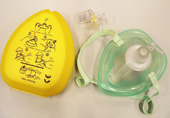
 When a person performs??cardiopulmonary (heart and lung) resuscitation (CPR), it is sometimes??recommended to provide rescue breathing. This is certainly the case when the??primary cause of the victima??s difficulty relates to failure to breathe??adequately, such as with a drowning episode. When CPR first arrived on the??landscape, laypersons were trained to perform mouth-to-mouth breathing (for??adults) or mouth-to-mouth and nose breathing (for infants and small children).
When a person performs??cardiopulmonary (heart and lung) resuscitation (CPR), it is sometimes??recommended to provide rescue breathing. This is certainly the case when the??primary cause of the victima??s difficulty relates to failure to breathe??adequately, such as with a drowning episode. When CPR first arrived on the??landscape, laypersons were trained to perform mouth-to-mouth breathing (for??adults) or mouth-to-mouth and nose breathing (for infants and small children).
Following growing concern about??transmission of diseases from blood and body fluids, laypersons were introduced to using masks or something similar to allow them to provide breathing??assistance (a??artificial respiration,a?? a??artificial ventilation,a?? a??rescue??breathing,a?? etc.) to non-breathing persons. Masks have been used for decades by??professional rescuers for ventilating patients, often in conjunction with the use??of bags in a a??bag-valve-maska?? configuration. The valve between the mask and bag??provides for one-way flow and prevents the backwash of vomitus, blood, liquid??from the lungs, or other fluids that might diminish the effectiveness of the??technique.
A number of excellent masks and??face shields are available on the market for rescuers to be able to??(relatively) safely blow air into a victima??s lungs. One example is the NuMask,??which is very useful and definitely indicated for personal (rescuer)??protection. However, the NuMask requires some practice to use successfully. The??masks typically used by professional rescuers require training and a strong set??of hands (sometimes two sets of hands, depending on the situation and facial??anatomy of the victim) to obtain a proper mask seal that can be maintained??during rescue breathing using a bag.
Current advice to??laypeople who might be called upon to provide rescue breathing is to carry and??utilize a shield or shielding mask. I recently read a report from Reuters in??which it was commented that a a??small study suggests??that lifeguards may perform better with direct mouth-to-mouth breathing.a?? For??the study reported by this news agency, trained lifeguards performed CPR on??mannequins using each of three breathing techniques a?? mouth-to-mouth, pocket??mask, and bag-valve-mask. In this study, using visible chest rise in the??mannequin, the lifeguards were successful 91 percent of the time with??mouth-to-mouth, 79 percent of the time with pocket masks and 59 percent of the??time with bag-valve-mask setups.
This announcement makes perfect??sense to me, because I have performed all three techniques. With mouth-to-mouth??breathing, the seal is created in a dynamic fashion by using the rescuera??s??pliable lips to create a firm (as airtight as possible) closure over the??victima??s mouth. This may be aesthetically displeasing, but it is effective and??efficient. One knows exactly how firmly to press, and can change the lip (seal)??position instantly to achieve the best seal possible. At the other end of the??spectrum is the bag-valve-mask apparatus, which requires fairly precise??placement, and is influenced by the victima??s facial anatomy, hair, and slippery??factors like oral secretions, sweat, exogenous water, blood, and vomited??gastric contents. Furthermore, it requires a reasonable amount of grip??strength, sufficiently large hands, and good technique to achieve and maintain??the seal. Somewhere in the middle is the smaller a??pocketa?? rescue mask or??shield, which usually fits fairly easily onto the victim and is easy to hold in??place while the rescuer blows into it.
It is important to observe, as did??Reuters, that this study could not be used to infer any direct effect on??survivor outcome, either morbidity or mortality, because it was performed on??mannequins, not on real victims.?? Other??factors should be considered besides chest rise, such as the fact that??supplemental oxygen can be administered using a port into the bag-valve-mask??apparatus, as well as knowing how long it takes for a rescuer to become fatigued,??thereby rendering any technique less effective or ineffective.
Given the risks associated with??disease transmission (which is estimated, but not definitively measured, in the??literature), we cannot infer that the improvement in effect with mouth-to-mouth??over the other techniques would argue for a change in recommendations. They??would, however, certainly emphasize the importance of proper training and??maintenance of skills. Learning a technique one time does not solve anyonea??s??educational needs over the long term. Refreshers are essential to sharpen your skills??to function well in an emergency situation.
This post, CPR: Mouth-to-Mouth Breathing May Have Some Advantages Over Mask-Assisted Breathing, was originally published on
Healthine.com by Paul Auerbach, M.D..
No comments:
Post a Comment